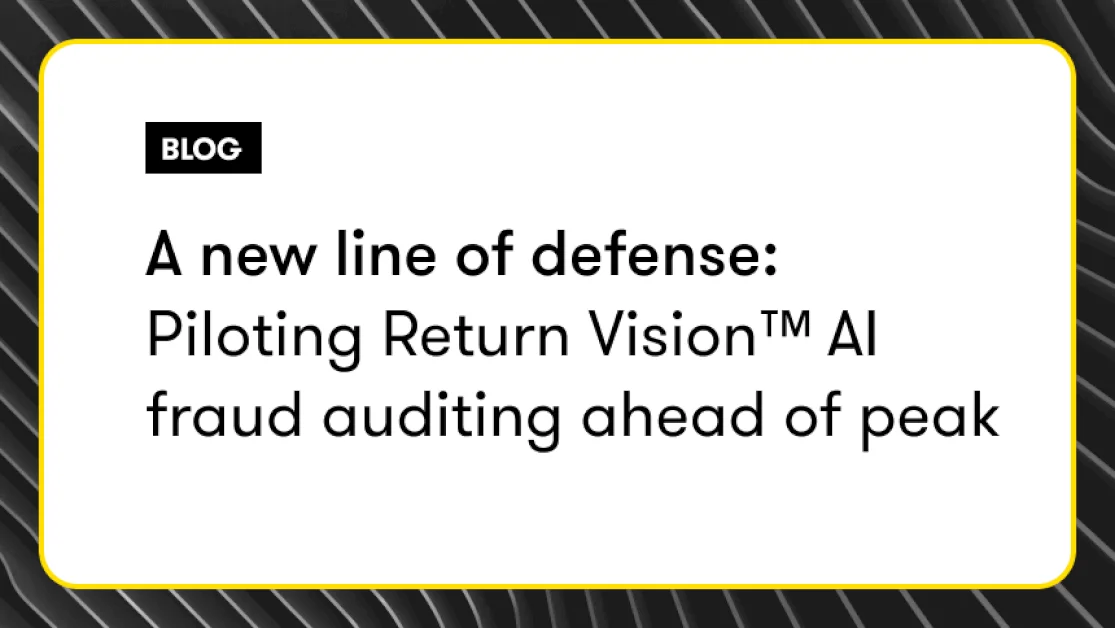Return fraud is running rampant. According to the 2025 Retail Returns Landscape report, a survey by the National Retail Federation and Happy Returns, almost half of shoppers admit to return fraud or abuse. More than 80% of retailers say fraud is a major issue, and 56% are raising fees for risky shoppers just to stay protected.
With retailers knowing this is one of their toughest challenges to tackle, they are hopeful new AI solutions will help change the tide. According to the report, 85% are already experimenting with AI to detect fraud, but nearly half say the results are mixed.
But, Happy Returns is ready to close the gap between innovation and aspiration. We’re testing what happens when AI is applied not just to data, but to the physical products being returned.
We don’t just manage returns — we’re evolving how we verify them
Happy Returns is well known for stopping the most blatant types of return fraud. Empty boxes, partial returns, and fake tracking IDs don’t get through because we only accept unboxed items and verify them on the spot. If there’s a barcode on the item, we scan it. If there isn’t, we use our patent-pending item puzzle to make sure what’s being returned is what was sold. Unboxed, in-person returns is our first line of defense, and it works.

As Jim Green, Director of Logistics and Fulfillment at Everlane, explains: “Just the fact of knowing an individual will physically handle and verify the product at the Return Bar® deters fraudsters from even attempting to commit fraud.”
But fraud is evolving, and so are the tactics behind it. For example, just like online marketplaces are flooded with “dupes” designed to mimic premium products, similar lookalike items are finding their way into returns. To the naked eye, they can pass as the real thing. Even for retailers, spotting these subtle differences is difficult without seeing and handling the product.
That’s why we’ve built new layers of protection — our second and third lines of defense — currently being piloted with select retail partners.
-
Behavioral risk flagging and delayed refunds
In partnership with Yofi, a No Fraud Company, we score returns for risk based on shopper behavior. The system looks for unusual patterns across timing, frequency, and geography. When these factors combine in unexpected ways, they can indicate higher-risk activity — allowing us to act quickly while keeping legitimate shoppers moving smoothly.
When these factors combine to form a distinct pattern, they can indicate high risk for return fraud, which is flagged by our system. When a return is flagged, the refund is delayed, pending the results of an audit at one of our Return Hub locations. The vast majority of returns come from good actors, and those shoppers won’t notice any delays or differences in the experience. For bad actors, however, this delay will enable a closer look and will close the loophole they’ve been exploiting with decoy returns.
-
Return Vision™ auditing
As part of the pilot, flagged items are pulled for a rapid audit at our Return Hubs. Using Return Vision™ software, each product is photographed and compared against photos from the merchant’s online catalog. Our AI model is trained to catch what the human eye might miss: incorrect or missing logos, a strap that’s too wide, a mislabeled tag, or fabric that doesn’t match. These subtle signals are often the difference between a genuine return and a costly decoy.
Why this matters to retailers
While still in pilot, Return Vision™ AI software is already demonstrating how physical product verification can enhance fraud detection in ways data alone can’t.
If you never touch the product, you can’t actually know what’s being returned matches what was sold. That’s why traditional systems often end up either too strict — blocking good shoppers and adding friction — or too lenient, letting bad actors through and costing retailers real money.
And most retailers will admit they’re not confident in their own defenses. According to a recent Happy Returns study, only 35% of retailers feel effective at tracking fraud. The rest are left scrambling to identify risky behavior, decide what to do with suspect items, and coordinate with 3PLs or internal teams on the fallout.
With Return Vision™ software, that burden shifts off your shoulders. We combine AI with our hands-on returns auditing process to deliver smarter fraud prevention — catching the fraud that matters while keeping good customers happy.
Early pilot results: stopping fraud before it reaches you
“With more than 85% of our returns now happening in person through the Return Bar® network, we’ve gained a level of confidence we never had with mail-ins,” said Jim Green, Director of Logistics and Fulfillment at Everlane. “By visually verifying every item, Happy Returns makes it nearly impossible for fraudsters to slip through—and we’re excited to build on that foundation with Return Vision.”
Nearly all returns that flow through the Return Bar® network are verified as legitimate — our system confirms that more than 99% of items returned by shoppers are genuine. For the small fraction of returns flagged for review (fewer than 1%), the findings are meaningful, averaging $218 per return in prevented loss.
Just as important as reducing the financial hit to retailers, this layered approach also eases the operational burden. Fraud audits happen within our network, not in your warehouse or customer service queue — freeing up your teams from chargebacks and giving you greater confidence that every return you accept is the real thing.
What’s next
Return Vision™ software is currently being piloted with a small group of retailers ahead of a broader rollout planned for 2026. These early pilots are helping refine our AI models, train them across more product types, and ensure seamless integration with merchant systems. This pilot is an early step toward a smarter, more secure future for returns.
Citations
1 Happy Returns internal data, October 2025




